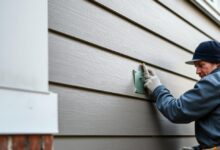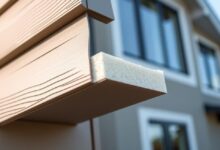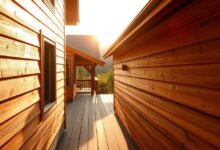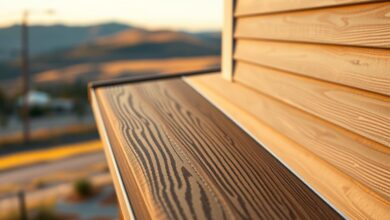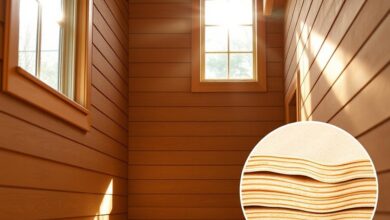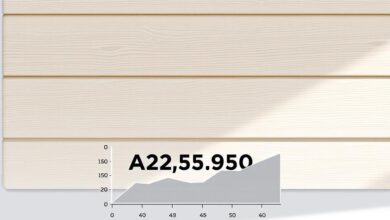Insulated Siding Maintenance: Tips for a Durable Home
Keeping your home’s exterior in good shape is key for its long life and looks. Insulated siding is a big investment. It makes your home more energy-efficient and keeps it safe from the weather.
For home exterior maintenance, you need to check things often and fix them quickly. This keeps your durable siding in great shape. It helps avoid expensive repairs and keeps your home’s value up.
Key Takeaways
- Regular inspections are key for keeping insulated siding in good shape.
- Fixing things quickly can save you from big repair costs.
- Good maintenance boosts your home’s energy efficiency.
- Durable siding shields your home from the weather.
- Looking after your home’s exterior keeps its value high.
Understanding Insulated Siding and Its Benefits
Insulated siding is a great mix of energy saving, lasting, and looking good. It’s a smart choice for homes. It keeps your home warm in winter and cool in summer, saving energy.
What Makes Insulated Siding Different
Insulated siding has a special layer that keeps it warm or cool. This layer cuts down on energy use. It also keeps your home’s temperature steady, making it more comfortable.
This siding is also tough and can handle harsh weather. It doesn’t get damaged easily, so you won’t have to fix it often.
The Long-term Value of Proper Maintenance
Keeping your insulated siding in good shape is key. Regular cleaning and checks can spot problems early. This saves you money and keeps your siding working well.
By taking care of your sidings care, you make your siding last longer. It looks great and adds value to your home. This makes your home more attractive and valuable.
How to Maintain Insulated Siding: Essential Practices
Keeping your insulated siding in good shape is key for homeowners. It keeps your home looking great and working well. Regular care helps your siding last longer and stay energy-efficient.
Regular Cleaning Techniques
Cleaning your siding often is a must. It gets rid of dirt, grime, and mildew that can harm it. Use gentle washing methods to avoid damage.
Gentle Washing Methods
To clean your siding, mix mild detergent with water. Use a soft-bristled brush or cloth to gently scrub. Start from the bottom to prevent dirt from running down. Then, rinse well with a garden hose to remove soap.
Cleaning Products Safe for Insulated Siding
Choose cleaning products made for exterior siding. Stay away from harsh chemicals and abrasive cleaners. Opt for solutions like oxygen bleach or simple soap and water.
Inspection Routines for Homeowners
Regular checks are key to spotting problems early. Homeowners should do monthly visual checks and a detailed annual inspection.
Monthly Visual Checks
Look for damage like cracks, dents, or loose panels in your monthly checks. Also, watch for mold or mildew, which can mean moisture issues.
Annual Detailed Inspection
Do a thorough check once a year. Look for gaps or openings around windows, doors, and joints. Make sure all panels are tight and there’s no water damage or warping.
| Inspection Task | Frequency | Purpose |
|---|---|---|
| Visual Check for Damage | Monthly | Identify signs of wear and tear |
| Detailed Inspection | Annually | Thoroughly assess siding condition and integrity |
| Cleaning | As Needed | Remove dirt and grime to prevent damage |
Addressing Common Insulated Siding Issues
Insulated siding can face many types of damage. It’s important for homeowners to spot and fix these problems quickly. Regular upkeep and timely repairs can make your siding last longer.
Identifying Damage and Wear
Regular checks are essential to catch issues early. Look for signs like cracks, warping, and moisture. These can be signs of bigger problems.
Cracks and Warping
Cracks and warping often come from weather or foundation settling. Regularly inspecting your siding helps find these issues early. For example, if you live in an area with big temperature changes, check for cracks more often.
Moisture and Mold Problems
Moisture can cause mold, harming your siding and home’s inside. Make sure water drains well and seal any gaps. Good ventilation also helps prevent moisture buildup.
DIY Repair Solutions
For small damages, you can try DIY fixes. This can save money and stop further damage.
Patching Small Damages
Fixing small cracks or damages is easy. A siding repair kit works well. Clean the area well before applying the patch for a strong fix.
Replacing Individual Panels
For bigger damage, you might need to replace panels. This means removing the old panel and putting in a new one. Make sure it’s well-fastened and sealed.
“Regular maintenance is key to extending the life of your insulated siding. By addressing issues promptly, homeowners can avoid costly repairs down the line.”
When to Call a Professional
DIY fixes work for small problems, but sometimes you need a pro. If the damage is big or you’re not sure what to do, get expert help. They can give the right solution and do the job safely.
Seasonal Maintenance Guide for Insulated Siding
To keep your insulated siding in great shape, adjust your maintenance routine with the seasons. Winter brings cold, while summer brings heat. Knowing these seasonal needs helps protect your siding and home.
Spring and Summer Care
Post-Winter Inspection and Cleaning
First, check your siding for winter damage like cracks or loose panels. Cleaning is key to remove dirt and mildew from winter. Use a mild detergent and soft-bristled brush for gentle cleaning.
To shield your siding from summer heat, ensure it’s sealed well. Check and reapply sealant if needed. Also, secure outdoor items to prevent damage from summer storms.
“Regular maintenance is key to extending the life of your insulated siding.”
Fall and Winter Preparation
Clearing Debris and Vegetation
Remove leaves and branches to stop moisture buildup and damage. Trimming back vegetation helps prevent damage and improves airflow.
Winterizing Your Insulated Siding
Look for gaps or cracks and seal them to keep cold air out. Use a siding-specific sealant for a tight seal. A well-maintained siding boosts your home’s energy efficiency in winter.
| Season | Maintenance Task | Benefit |
|---|---|---|
| Spring/Summer | Inspect and clean siding | Removes dirt and grime, improving appearance |
| Fall/Winter | Clear debris and seal gaps | Prevents damage from moisture and cold air |
Extending the Lifespan of Your Insulated Siding
Keeping your insulated siding in top shape is key. Simple steps can make a big difference. This way, your siding will last longer and work better.
Preventive Measures Against Weather Damage
Weather can harm your siding. Proper drainage solutions and UV protection strategies are vital. They help protect your siding from the elements.
Proper Drainage Solutions
Water buildup around your siding is a big no-no. Make sure your gutters and downspouts work right. Also, the ground should slope away from your home. A good drainage system keeps water away from your siding.
UV Protection Strategies
UV rays can make your siding fade and wear out. Use a UV-resistant coating or siding that protects against UV rays. Also, check your siding often for UV damage and fix it right away.
Landscaping Considerations for Siding Protection
Your landscaping choices can affect your siding’s life. Maintaining a safe distance between plants/trees and the siding is important. Also, manage your sprinkler systems carefully.
Safe Distance for Plants and Trees
Plants and trees should not be too close to your siding. This prevents damage from branches and roots. It also stops moisture from building up against the siding.
Managing Sprinkler Systems
Make sure your sprinklers don’t spray too much water on your siding. Adjust them so they don’t hit the siding directly. This helps avoid water damage.
| Maintenance Task | Frequency | Benefit |
|---|---|---|
| Cleaning Siding | Twice a year | Removes dirt and debris |
| Inspecting Gutters | Quarterly | Ensures proper drainage |
| Checking for UV Damage | Annually | Identifies need for UV protection |
Conclusion
Proper care and maintenance are key to keeping insulated siding in top shape. This helps extend its life and keeps your home looking great. By following the tips in this article, you can keep your siding in excellent condition.
Regular cleaning and inspections are vital. They help spot and fix problems early. This prevents expensive repairs and keeps your home looking good.
Understanding the importance of siding maintenance is the first step. Being proactive about repairs and having a cleaning routine are also important. This way, your home’s exterior will stay strong and attractive for many years.
